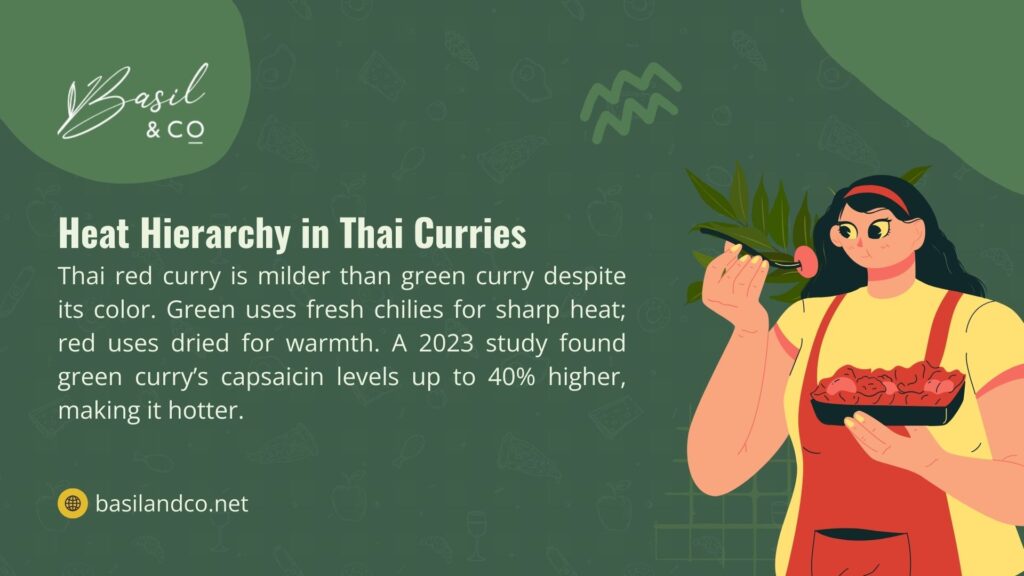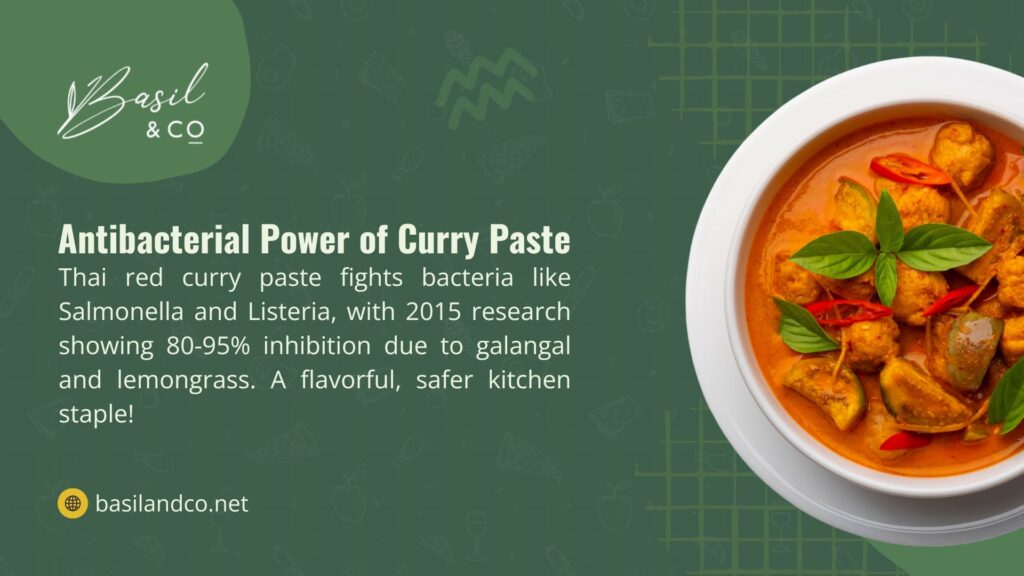Thai red curry sits at number 10 on TasteAtlas’s global curry rankings, with over 659,000 people rating different curry varieties worldwide. In Thailand, you’ll mostly find this curry in tourist areas. Locals prefer other varieties for everyday meals. The version we know and love actually developed partly to suit international tastes.
The dish succeeds because it hits that sweet spot between exotic and familiar. The coconut milk provides comfort while the curry paste delivers enough heat to keep things interesting. Food scientists have studied why certain flavor combinations work so well together – turns out the fat in coconut milk actually helps carry the aromatic compounds from the spices, making everything taste more intense.
Traditional preparation involves pounding ingredients in a granite mortar for hours. Most home cooks skip this step entirely, and honestly, good jarred paste gets you 95% of the way there if you know how to use it properly.
Why This Thai Red Curry Recipe Tastes So Good
Those dried red chilies that give the curry its color also provide a different heat profile than fresh green chilies. Red chilies offer warmth without the sharp bite that makes people grab for their water glass. Combined with coconut milk’s natural sweetness, you get something that builds heat slowly instead of punching you in the mouth.
The transformation happens when curry paste meets hot oil. That sizzling releases essential oils locked inside the dried spices and aromatics. Skip this step and your curry tastes flat, no matter how good your other ingredients are.
Professional kitchens make fresh paste daily, but most home cooks rely on jarred versions. The quality difference between brands is huge. Some taste like actual Thailand, others like generic red paste with artificial coloring.
Shopping for the Right Groceries
Half the battle happens at the grocery store. Thai red curry recipe success depends on getting decent ingredients, especially the paste and coconut milk.
Coconut Milk
Full-fat coconut milk is non-negotiable. Light versions contain mostly water and gums to fake thickness. Real coconut milk separates in the can – that thick layer on top provides the richness that makes curry taste right.
Brands matter here, too. Chaokoh and Aroy-D consistently deliver good results. Store brands often have a watery taste or an unpleasant aftertaste.
Protein Options
Chicken thighs stay tender even if slightly overcooked. Breast meat turns dry and stringy if you’re not careful with timing. Cut against the grain for beef; otherwise, it becomes chewy.
Shrimp cooks fast – add it at the very end or it turns rubbery. Firm tofu works, but it needs to be pressed first to remove excess water.
Vegetables
Thai eggplant looks like small green golf balls and has a slightly bitter taste that balances the curry’s richness. Regular eggplant substitutes fine if cut into similar-sized pieces.
Bamboo shoots add textural interest without a strong flavor. Green beans should stay crisp-tender, not mushy. Bell peppers aren’t traditional, but they add sweetness and color that most people enjoy.
Essential Seasonings
Fish sauce smells awful, but provides umami depth that salt alone can’t match.
Palm sugar has caramelized notes that regular sugar lacks. Brown sugar works as a backup but doesn’t taste quite the same.
Kaffir lime leaves smell intensely citrusy. Tear them instead of cutting to release more oils. Thai basil differs from Italian basil – it’s more floral and slightly spicy.

Thai Red Curry Recipe
Prep Time: 15 minutes
Cook Time: 20 minutes
Total Time: 35 minutes
Servings: 4 people
Ingredients
Base:
- 3 tablespoons red curry paste
- 1 can (14 oz) full-fat coconut milk
- 2 tablespoons vegetable oil
- 1 tablespoon fish sauce
- 1 tablespoon palm sugar or brown sugar
Protein:
- 1 pound chicken thighs, cut into bite-sized pieces
Vegetables:
- 1 small eggplant, cubed
- 1/2 cup bamboo shoots, drained
- 1 red bell pepper, sliced
- 1 cup green beans, cut into 2-inch pieces
Finishing:
- 4 kaffir lime leaves, torn
- 1/4 cup Thai basil leaves
- Cooked jasmine rice
Instructions
- Cut vegetables into uniform pieces. This prevents some from overcooking while others stay raw.
- Heat oil in a large pan over medium-high heat. Add curry paste and cook 2-3 minutes, stirring constantly, until darkened and fragrant. Don’t skip this step.
- Pour in half the coconut milk, stirring to combine. Cook for 2 minutes until oil separates on the surface. Add remaining coconut milk slowly while stirring.
- Stir in fish sauce and sugar. Taste and adjust. It should balance salty, sweet, and spicy.
- Add chicken pieces and simmer for 5-6 minutes until nearly cooked through.
- Add eggplant and bamboo shoots first, and cook for 3 minutes. Add bell pepper and green beans, cook 2-3 minutes more until crisp-tender.
- Stir in torn lime leaves and cook for 1 minute. Remove from heat and add basil leaves.
- Ladle over jasmine rice. Curry should be creamy but not thick.
Notes
- Oil separation is normal and desired – indicates proper technique
- Vegetables should retain some bite and bright color
- Curry improves overnight as flavors develop
- For the vegetarian version, substitute soy sauce for fish sauce

Common Problems and Solutions
Most home cooks make the same mistakes repeatedly. Here are some common problems that arise:
- Watery curry usually means light coconut milk or not frying the paste properly. Fix it by cooking longer to reduce the liquid or adding more paste.
- Bland flavor happens when the paste doesn’t get fried first or when using inferior brands. That initial frying step develops flavors that can’t happen any other way.
- Overcooked vegetables result from adding everything simultaneously. Different vegetables need different cooking times. Plan accordingly.
- Too spicy or not spicy enough depends on the amount and the brand’s heat levels. Start conservative and add more paste gradually.
Storage and Leftovers
Curry keeps well refrigerated for 3-4 days. Flavors actually improve overnight as everything continues melding together. Freezes successfully for several months, though vegetable textures soften slightly.
Reheat gently over low heat, adding coconut milk if it looks too thick. Oil may separate again during reheating – this is normal.
Nutritional Information
| Nutrient | Per Serving |
| Calories | 380-420 |
| Fat | 26g |
| Carbohydrates | 16g |
| Protein | 28g |
| Sodium | 950mg |
Values approximate, varying with specific ingredients used

Variations Worth Trying
Seafood curry works wonderfully with shrimp, scallops, or white fish. Add seafood during the final minutes to prevent overcooking.
Vegetarian versions substitute soy sauce for fish sauce and can include tofu, mushrooms, or extra vegetables. Check out more Thai vegetable dishes for inspiration.
Milder heat levels use less paste and more coconut milk. Good option for children or those sensitive to spice.
Pair with pad thai for a complete Thai meal, or start with tom yum soup as an appetizer.
Experience Authentic Thai Cuisine
Sometimes the best way to understand authentic Thai flavors is to taste them prepared by experts. When you want to experience the real deal without the guesswork, professionally prepared Thai cuisine showcases the balance and complexity that make these dishes so special.
Basil & Co brings authentic Thai flavors directly to your table with carefully crafted dishes that honor traditional techniques and authentic ingredients. From perfectly balanced curries to aromatic stir-fries, each dish demonstrates the principles that make Thai cuisine extraordinary.
Check out our Menu for traditional Thai dishes prepared with the same attention to balance and flavor that you’ve learned about in this recipe.


